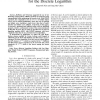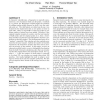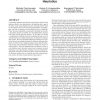113 search results - page 18 / 23 » Attacks on physical-layer identification |
JCP
2007
13 years 8 months ago
2007
This paper discusses breaking the escalation cycle that locks cyber intruders and their targets in a state where targets are perennially resigned to attacks and intruders are at...
TIT
2010
13 years 3 months ago
2010
Hoffstein and Silverman suggested the use of low Hamming weight product (LHWP) exponents to accelerate group exponentiation while maintaining the security level. With LHWP exponent...
CCS
2006
ACM
14 years 10 days ago
2006
ACM
In biometric identification, a fingerprint is typically represented as a set of minutiae which are 2D points. A method [4] to protect the fingerprint template hides the minutiae b...
FC
2006
Springer
14 years 8 days ago
2006
Springer
Abstract. Phishing, or web spoofing, is a growing problem: the Anti-Phishing Working Group (APWG) received almost 14,000 unique phishing reports in August 2005, a 56% jump over the...
ACSAC
2010
IEEE
13 years 6 months ago
2010
IEEE
A promising method for the detection of previously unknown code injection attacks is the identification of the shellcode that is part of the attack vector using payload execution....



